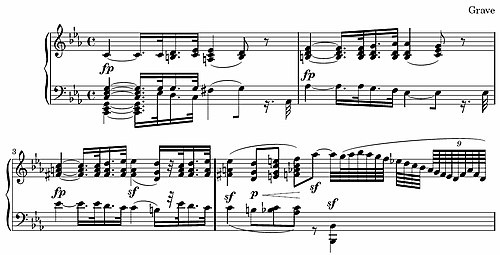Music: Glenn Gould - Pathetique - Patetica - Beethoven - Data en Espanol and English
Posted by Ricardo Marcenaro | Posted in Music: Glenn Gould - Pathetique - Patetica - Beethoven - Data en Espanol and English | Posted on 15:34
Glenn Gould - Pathetique pt. I (Beethoven)
La Sonata es fundamental en la producción pianística por sus valores de abstracción musical, así como por sus connotaciones filosóficas y las intuiciones de futuro de índole estructural (la estructura interna de la sonata es seguramente la más avanzada de las obras del primer período de Beethoven). Es considerada una de las obras cumbres de Beethoven, y una de las más interpretadas en público, tanto en vida del compositor como actualmente.
Movimientos
La sonata contiene tres movimientos:- Grave; allegro di molto e con brio.
- Adagio cantabile.
- Rondo: allegro
El famoso segundo movimiento, Adagio cantabile, es de una sosegada belleza y suavidad, aparentemente simple pero armónicamente densa. La idea principal se puede encontrar en otras obras de Beethoven como el cuarteto Op.18 Nº2 y en el Septimino Op.20.
El último movimiento, Rondó allegro, es rico en inventiva y delicadeza, aunque de carga emocional inferior a la de los dos intensos movimientos anteriores.
Los expertos destacan la unificación temática de la sonata a partir de una célula cíclica, que aparece en todas las secciones de la sonata: el núcleo temático del Grave se reproduce en el Allegro, y el segundo tema del Allegro es una amplificación del Grave. También es la base para el final de la melodía del Adagio cantabile y para el tema principal del Rondó. Se suelen destacar además las ambiciones sinfónicas y tímbricas de la sonata, muy rica en texturas.
Glenn Gould - Pathetique pt. II (Beethoven)
Prominent musicologists debate whether or not the Pathétique may have been inspired by Mozart's piano sonata K. 457, since both compositions are in C minor and have three very similar movements. The second movement, "Adagio cantabile", especially, makes use of a theme remarkably similar to that of the spacious second movement of Mozart's sonata.[3] However, Beethoven's sonata uses a unique motif line throughout, a major difference from Haydn or Mozart’s creation.[1]
Movements
- Grave (Slowly, with solemnity) – Allegro di molto e con brio (Quickly, with much vigour)
- Adagio cantabile (Slowly, in a singing style)
- Rondo: Allegro (Quickly)
Grave – Allegro di molto e con brio
The first movement is in sonata form. It begins with a slow introductory theme, marked Grave. The exposition, marked Allegro di molto con brio, is in 22 time (alla breve) in the home key of C minor and features three themes. Theme 1 features an aggressive rocket theme covering two octaves, accompanied with constant tremolo octaves in the left hand. Beethoven then makes use of unorthodox mode-mixture, as he presents the second theme in E-flat minor rather than its customary parallel major. This theme is more lyrical and makes use of grace notes and crossed hands. Theme 3 has modulated to the mediant, E-flat major, and features an Alberti-type figuration for the bass with tremolo. A codetta, with ideas from the opening allegro, closes the section. Some performers of the sonata include the introduction in the exposition repeat though others return to the beginning of the allegro section.
The development section begins in the key of G minor. In this section, Beethoven extends Haydn's compositional practice by returning to the introductory section. After this reappearance of the Grave, the composer generates suspense with an extended dominant preparation.
The recapitulation brings back the themes of the exposition in different keys: themes 1 and 3 are played in the tonic key of C minor, then theme 2 is played in the unexpected key of F minor but then returns to the tonic key. The coda is very dramatic and includes a brief reminder of the Grave before ending with a swift cadence.

Adagio cantabile
The Adagio movement, a grand expansive movement utilized by future composers, often in chamber music, opens with a famous cantabile melody. This theme is played three times, always in A-flat major, separated by two modulating episodes, making it a five-part rondo. The first episode is set in F minor (relative minor of A-flat major), further modulating to E-flat major before returning to the main theme. The second episode begins in A-flat minor and modulates to E major. With the final return of the main theme, the accompaniment becomes richer and takes on the triplet rhythm of the second episode. There is a brief coda.|
|

The cantabile from this movement was used as the theme music for radio's most widely listened-to classical music program,[4][5] Adventures in Good Music, which aired nationally in the United States and in many other countries from 1970 to 2007. The theme was performed by Karl Haas, the program's host.
Rondo: Allegro
The sonata closes with a cut time movement in C minor. The main theme closely resembles the second theme of the Allegro of the first movement: its melodic pattern is identical for its first four notes, and its rhythmic pattern for the first eight. There is also a modified representation of the melody from the second movement, thus connecting all three movements together. The movement's sonata rondo form includes a coda. The three rondo episodes are in E-flat major, A-flat major, and C major. The movement can be thought as related to Beethoven's Piano Concerto No. 3 in C minor, Op. 37. The common use of sforzando creates a forceful effect.
Glenn Gould - Pathetique pt. III (Beethoven)
Music: Glenn Gould - Pathetique - Patetica - Beethoven - Data en Espanol and English






Comments (0)
Publicar un comentario